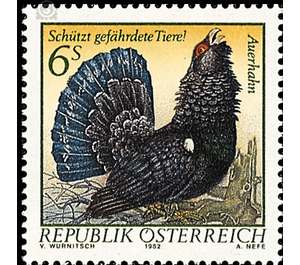natural reserve - Austria / II. Republic of Austria 1982 - 6 Shilling
Theme: Animals
| Country | Austria / II. Republic of Austria |
| Issue Date | 1982 |
| Face Value | 6.00 |
| Color | multi-colored yellow |
| Printing Type | combination printing |
| Stamp Type | Commemorative |
| Item Type | Stamp |
| Chronological Issue Number | 1062 |
| Chronological Chapter | OOS-OE2 |
| SID | 810857 |
| In 67 Wishlists | |
The range of the capercaillie once extended from Spain via Europe to North Asia, from the southern edge of the Alps to Scandinavia and to the northwestern Mongolia. There are seven races altogether. The stocks of capercaillie have declined steadily in recent decades. The reasons for this include climate change, the conversion of mixed forests into monocultures and the decline in insect nutrition for the chicks. The repopulation of areas is difficult. It has proven to be useful to support weak populations by animals from captive breeding. The Forschungsgemeinschaft Wilhelminenberg, under its director Otto König, developed methods for breeding and settling in twenty years of trial work and had already released succulent owls into the wild at the time of issue of the special stamp series. The food of the adult grouse consists mainly of spruce and pine needles during the winter. During the summer, the grouse eats a wide variety of buds, softwood shoots, all sorts of plants, berries, but also insects and their larvae. Especially chicks need a lot of insect food.


